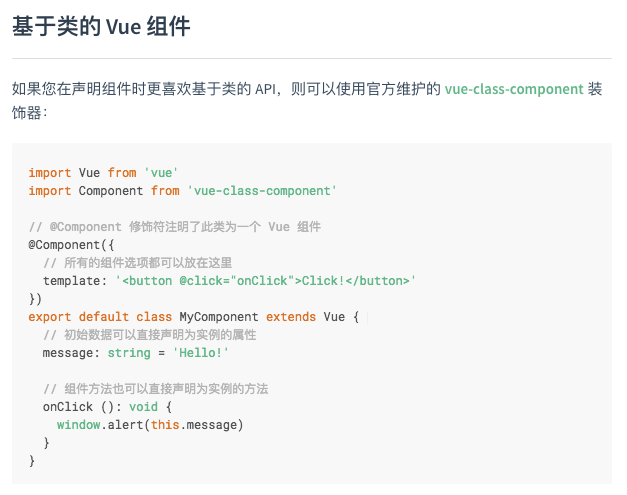Vue 引入 TypeScript
vue init airyland/vux2 projectName
增加开发包的依赖
npm install typescript ts-loader --save-dev
增加运行依赖包(安装vue的官方插件)
npm i vue-class-component vue-property-decorator --save
说明:
vue-class-component:强化 Vue 组件,使用 TypeScript/装饰器 增强 Vue 组件 vue-property-decorator:在 vue-class-component 上增强更多的结合 Vue 特性的装饰器 ts-loader:TypeScript 为 Webpack 提供了 ts-loader,其实就是为了让webpack识别 .ts .tsx文件
配置 webpack
首先找到./build/webpack.base.conf.js
1.找到entry.app 将main.js 改成 main.ts, 顺便把项目文件中的main.js也改成main.ts, 里面内容保持不变
如下所示
entry: {
app: './src/main.ts'
}
2.找到resolve.extensions 里面加上.ts 后缀 (是为了之后引入.ts的时候不写后缀)
如下所示
resolve: {
extensions: ['.js', '.vue', '.json', '.ts'],
alias: {
'@': resolve('src')
}
}
3.找到module.rules 添加webpack对.ts的解析
module: {
rules: [
{
test: /.(js|vue)$/,
loader: 'eslint-loader',
enforce: 'pre',
include: [resolve('src'), resolve('test')],
options: {
formatter: require('eslint-friendly-formatter')
}
},
// 从这里复制下面的代码就可以了
{
test: /.tsx?$/,
loader: 'ts-loader',
exclude: /node_modules/,
options: {
appendTsSuffixTo: [/.vue$/],
}
},
// 复制以上的
}
}
ts-loader 会检索当前目录下的 tsconfig.json 文件,根据里面定义的规则来解析.ts文件(就跟.babelrc的作用一样)
添加 tsconfig.json
接下来在根路径下创建tsconfig.json文件
这里有一份参考的 tsconfig.json 配置
{
// 编译选项
"compilerOptions": {
// 输出目录
"outDir": "./output",
// 是否包含可以用于 debug 的 sourceMap
"sourceMap": true,
// 以严格模式解析
"strict": true,
// 采用的模块系统
"module": "esnext",
// 如何处理模块
"moduleResolution": "node",
// 编译输出目标 ES 版本
"target": "es5",
// 允许从没有设置默认导出的模块中默认导入
"allowSyntheticDefaultImports": true,
// 将每个文件作为单独的模块
"isolatedModules": false,
// 启用装饰器
"experimentalDecorators": true,
// 启用设计类型元数据(用于反射)
"emitDecoratorMetadata": true,
// 在表达式和声明上有隐含的any类型时报错
"noImplicitAny": false,
// 不是函数的所有返回路径都有返回值时报错。
"noImplicitReturns": true,
// 从 tslib 导入外部帮助库: 比如__extends,__rest等
"importHelpers": true,
// 编译过程中打印文件名
"listFiles": true,
// 移除注释
"removeComments": true,
"suppressImplicitAnyIndexErrors": true,
// 允许编译javascript文件
"allowJs": true,
// 解析非相对模块名的基准目录
"baseUrl": "./",
// 指定特殊模块的路径
"paths": {
"jquery": [
"node_modules/jquery/dist/jquery"
]
},
// 编译过程中需要引入的库文件的列表
"lib": [
"dom",
"es2015",
"es2015.promise"
]
}
}
顺便贴一份自己的配置
{
"include": [
"src/**/*"
],
"exclude": [
"node_modules"
],
"compilerOptions": {
"allowSyntheticDefaultImports": true,
"experimentalDecorators": true,
"allowJs": true,
"module": "esnext",
"target": "es5",
"moduleResolution": "node",
"isolatedModules": true,
"lib": [
"dom",
"es5",
"es2015.promise"
],
"sourceMap": true,
"pretty": true
}
}
让 ts 识别 .vue
由于 TypeScript 默认并不支持 *.vue 后缀的文件,所以在 vue 项目中引入的时候需要创建一个 vue-shim.d.ts 文件,放在项目项目对应使用目录下,例如 src/vue-shim.d.ts
declare module "*.vue" {
import Vue from "vue";
export default Vue;
}
意思是告诉 TypeScript *.vue 后缀的文件可以交给 vue 模块来处理。
而在代码中导入 *.vue 文件的时候,需要写上 .vue 后缀。原因还是因为 TypeScript 默认只识别 *.ts 文件,不识别 *.vue 文件:
import Component from 'components/component.vue'
改造 .vue 文件
在这之前先让我们了解一下所需要的插件(下面的内容需要掌握es7的装饰器, 就是下面使用的@符号)
vue-class-component
vue-class-component 对 Vue 组件进行了一层封装,让 Vue 组件语法在结合了 TypeScript 语法之后更加扁平化:
<template>
<div>
<input v-model="msg">
<p>msg: {{ msg }}</p>
<p>computed msg: {{ computedMsg }}</p>
<button @click="greet">Greet</button>
</div>
</template>
<script lang="ts">
import Vue from 'vue'
import Component from 'vue-class-component'
@Component
export default class App extends Vue {
// 初始化数据
msg = 123
// 声明周期钩子
mounted () {
this.greet()
}
// 计算属性
get computedMsg () {
return 'computed ' + this.msg
}
// 方法
greet () {
alert('greeting: ' + this.msg)
}
}
</script>
上面的代码跟下面的代码作用是一样的
export default {
data () {
return {
msg: 123
}
}
// 声明周期钩子
mounted () {
this.greet()
}
// 计算属性
computed: {
computedMsg () {
return 'computed ' + this.msg
}
}
// 方法
methods: {
greet () {
alert('greeting: ' + this.msg)
}
}
}
vue-property-decorator
vue-property-decorator 是在 vue-class-component 上增强了更多的结合 Vue 特性的装饰器,新增了这 7 个装饰器:
@Emit@Inject@Model@Prop@Provide@Watch@Component(从vue-class-component继承)
在这里列举几个常用的@Prop/@Watch/@Component, 更多信息,详见官方文档
import { Component, Emit, Inject, Model, Prop, Provide, Vue, Watch } from 'vue-property-decorator'
const s = Symbol('baz')
@Component
export class MyComponent extends Vue {
@Emit()
addToCount(n: number){ this.count += n }
@Emit('reset')
resetCount(){ this.count = 0 }
@Inject() foo: string
@Inject('bar') bar: string
@Inject(s) baz: string
@Model('change') checked: boolean
@Prop()
propA: number
@Prop({ default: 'default value' })
propB: string
@Prop([String, Boolean])
propC: string | boolean
@Provide() foo = 'foo'
@Provide('bar') baz = 'bar'
@Watch('child')
onChildChanged(val: string, oldVal: string) { }
@Watch('person', { immediate: true, deep: true })
onPersonChanged(val: Person, oldVal: Person) { }
}
上面的代码相当于:
const s = Symbol('baz')
export const MyComponent = Vue.extend({
name: 'MyComponent',
inject: {
foo: 'foo',
bar: 'bar',
[s]: s
},
model: {
prop: 'checked',
event: 'change'
},
props: {
checked: Boolean,
propA: Number,
propB: {
type: String,
default: 'default value'
},
propC: [String, Boolean],
},
data () {
return {
foo: 'foo',
baz: 'bar'
}
},
provide () {
return {
foo: this.foo,
bar: this.baz
}
},
methods: {
addToCount(n){
this.count += n
this.$emit("add-to-count", n)
},
resetCount(){
this.count = 0
this.$emit("reset")
},
onChildChanged(val, oldVal) { },
onPersonChanged(val, oldVal) { }
},
watch: {
'child': {
handler: 'onChildChanged',
immediate: false,
deep: false
},
'person': {
handler: 'onPersonChanged',
immediate: true,
deep: true
}
}
})
开始修改App.vue文件
- 在
script标签上加上lang="ts", 意思是让webpack将这段代码识别为typescript而非javascript - 修改vue组件的构造方式( 跟
react组件写法有点类似, 详见官方 ), 如下图 - 用
vue-property-decorator语法改造之前代码

当然也可以直接复制下面的代码替换就可以了
<template>
<div id="app">
<img src="./assets/logo.png">
<router-view/>
</div>
</template>
<script lang="ts">
import Vue from 'vue'
import Component from 'vue-class-component'
@Component({})
export default class App extends Vue {
}
</script>
<style>
#app {
font-family: 'Avenir', Helvetica, Arial, sans-serif;
-webkit-font-smoothing: antialiased;
-moz-osx-font-smoothing: grayscale;
text-align: center;
color: #2c3e50;
margin-top: 60px;
}
</style>
接下来用相同的方式修改HelloWorld.vue即可
npm run dev
这个时候运行项目就应该能正常跑起来了
到这里我们的配置就已经结束了